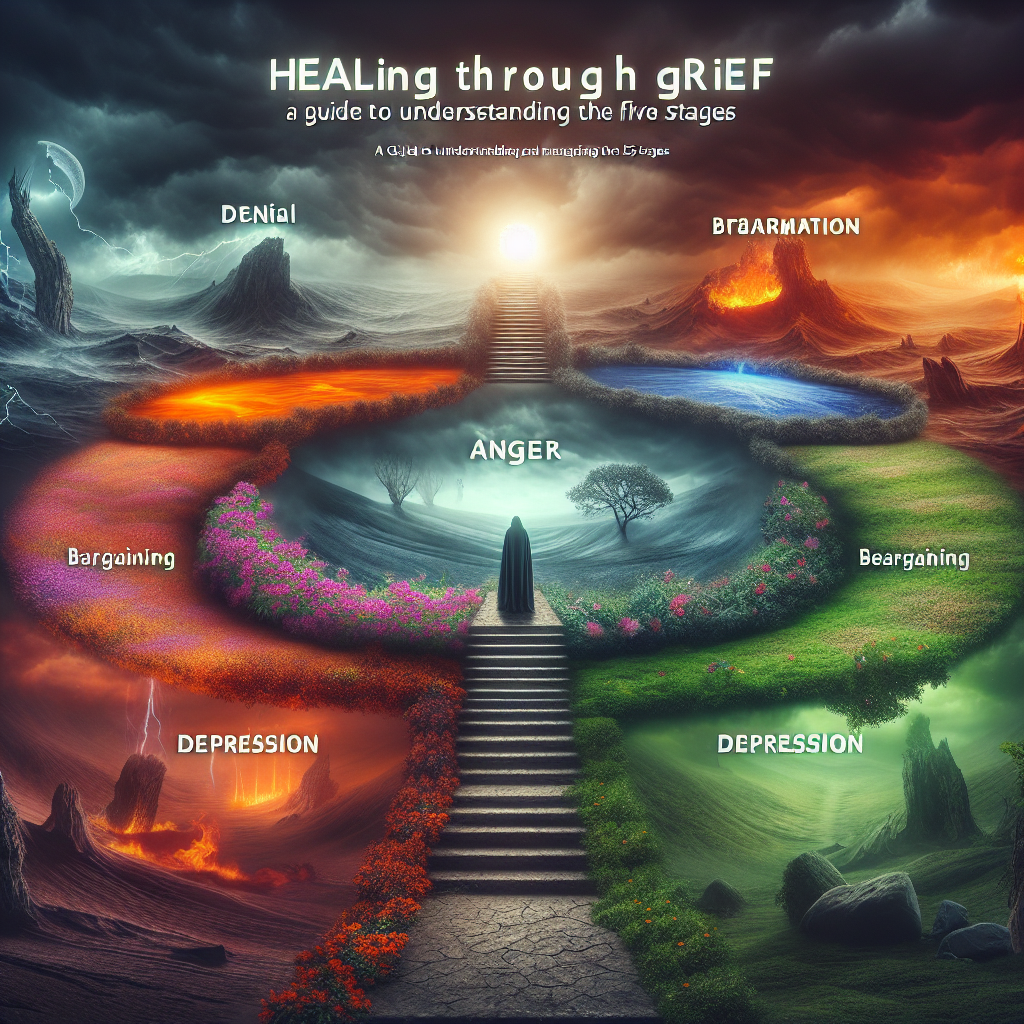
Ultimate Healing Through Grief: A Guide to Understanding and Managing the Five Stages
Introduction
Grief is a profound experience, uniquely felt by every individual. It can encompass a mix of emotions, often leaving us feeling lost and isolated. In this comprehensive guide, Healing Through Grief: A Guide to Understanding and Managing the Five Stages, we will explore how understanding the stages of grief can lead to healing. This guide not only highlights the importance of recognizing these stages but also presents practical strategies for navigating through them, ultimately fostering resilience and growth.
The Five Stages of Grief
Understanding the Model
In 1969, Elisabeth Kübler-Ross introduced the Five Stages of Grief: Denial, Anger, Bargaining, Depression, and Acceptance. This model has become a cornerstone for understanding human grief. Although it’s vital to know that not everyone goes through all these stages in a linear fashion, they provide a helpful framework for recognizing our emotional journey.
Table 1: The Five Stages of Grief
| Stage | Description | Common Reactions |
|---|---|---|
| Denial | The initial shock of loss may lead to disbelief. | Numbness, avoidance, confusion. |
| Anger | Frustration and helplessness manifest as anger. | Irritability, resentment toward others. |
| Bargaining | Seeking a way to avoid the grief. | Negotiating with fate (“If only…”). |
| Depression | The deep sense of loss becomes more pronounced. | Sadness, withdrawal, despair. |
| Acceptance | Coming to terms with the loss and finding meaning. | Hope, moving forward, renewed purpose. |
Case Study 1: Sarah’s Journey Through Loss
Sarah lost her husband unexpectedly. Initially, she was in a state of denial, often avoiding conversations about her husband’s death. However, gradually, she experienced intense anger directed at her circumstances and even her deceased husband, questioning why such a tragedy had to happen to her. After several months, she started bargaining, wishing she could have done something to prevent the loss.
Analysis: Sarah’s journey illustrates that initial denial is common and can later give way to anger and bargaining. Recognizing these stages helped Sarah understand her feelings, enabling her to seek support.
Managing Each Stage Effectively
1. Healing Through Denial
Understanding that denial is a natural reaction to grief helps validate your emotions. During this stage:
- Seek Support: Engage with friends or a counselor to express your feelings.
- Journaling: Write down your thoughts to help process your emotions.
2. Healing Through Anger
Anger can be a source of power if channeled effectively:
- Physical Activity: Exercise can relieve pent-up frustration.
- Creative Outlets: Channel your emotions into art or music.
Case Study 2: Mark’s Anger Management
Mark, who lost his job and subsequently his sense of purpose, experienced profound anger. Instead of lashing out, he began a boxing class, which helped him manage his frustration constructively.
Analysis: Mark’s experience shows how physical activity can provide an outlet for anger, demonstrating that healing through the anger stage can be achieved in healthy ways.
Healing Through Bargaining and Depression
These two stages often intertwine, leading to feelings of hopelessness.
3. Healing Through Bargaining
Bargaining can be a way to regain a sense of control:
- Reflection: Use this time to reflect on what you valued in life.
- Support Groups: Sharing your thoughts with others who understand can be comforting.
4. Healing Through Depression
Depression requires compassionate self-care:
- Professional Help: Seeking therapy or medication can provide essential support.
- Mindfulness and Meditation: Practices that encourage mindfulness can aid in managing depressive feelings.
Case Study 3: Emily’s Path to Acceptance
Emily faced intense depression following her father’s death. Through therapy, she learned to embrace her emotions rather than resist them. After months of work, she found herself ready to accept her new reality and honor her father’s memory by living life to its fullest.
Analysis: Emily’s story underscores the importance of professional help and self-compassion during the depression stage of grief, emphasizing that healing through grief is possible with the right support.
Finding Acceptance
5. Healing Through Acceptance
Acceptance does not mean forgetting. It means finding ways to carry the memory of your loss while looking forward:
- Create Rituals: Honor your loved one through memorials or family traditions.
- Set New Goals: Redirect your focus towards new aspirations that inspire growth.
Creating Your Own Healing Journey
Tracking Your Progress
Utilizing tools such as a grief journal can help track the emotional stages:
- Table 2: Grief Journal Template
| Date | Stage | Feelings | Actions Taken |
|---|---|---|---|
| 2023-01-01 | Denial | Shock, Disbelief | Talked to friends about memories. |
| 2023-01-15 | Anger | Frustration, Resentment | Started jogging and wrote poems. |
| 2023-02-01 | Bargaining | Wishing for more time | Joined a support group. |
| 2023-03-01 | Depression | Sadness, Numbness | Began therapy sessions. |
| 2023-04-01 | Acceptance | Hope, Peace | Planned a memorial garden. |
Setting Goals for Pathways to Healing
Establish both short-term and long-term goals that align with your personal healing journey. These milestones can serve as motivation and help you track progress.
Importance of Community Support
Building a network of support is essential for navigating grief. Whether through friends, family, or support groups, a strong community can make the healing journey feel less isolating.
Conclusion
The journey through grief is undeniably challenging, but it is also an opportunity for reflection, growth, and deeper connections. Healing Through Grief: A Guide to Understanding and Managing the Five Stages serves not only as a roadmap but also as an invitation to embrace the process. Whether you’re experiencing grief yourself or supporting someone else, recognizing and understanding each stage can be transformative.
Healing is not a linear path, but by utilizing the insights shared in this guide, individuals can foster resilience, compassion, and hope in their healing journeys.
FAQs
1. Can everyone experience all five stages of grief?
Not everyone goes through all five stages, nor do they do so in a linear manner. Grief is a unique experience for everyone.
2. How long does grief last?
Grief is personal, and there is no set timeline. Some may find it lessens after a few months, while others might feel the impact for years.
3. Can I skip stages in the grieving process?
Yes, it’s possible to skip stages or move back and forth between them as you work through your emotions.
4. What should I do if I feel stuck in my grief?
If you feel stuck, consider reaching out to a therapist or grief counselor who specializes in grief support.
5. How can I support someone else who is grieving?
Offer your presence, listen without judgment, and avoid offering clichéd advice. Sometimes, just being there is the most supportive action you can take.
In embracing this journey of Healing Through Grief: A Guide to Understanding and Managing the Five Stages, remember to be gentle with yourself and trust your process. You are not alone on this path.
















